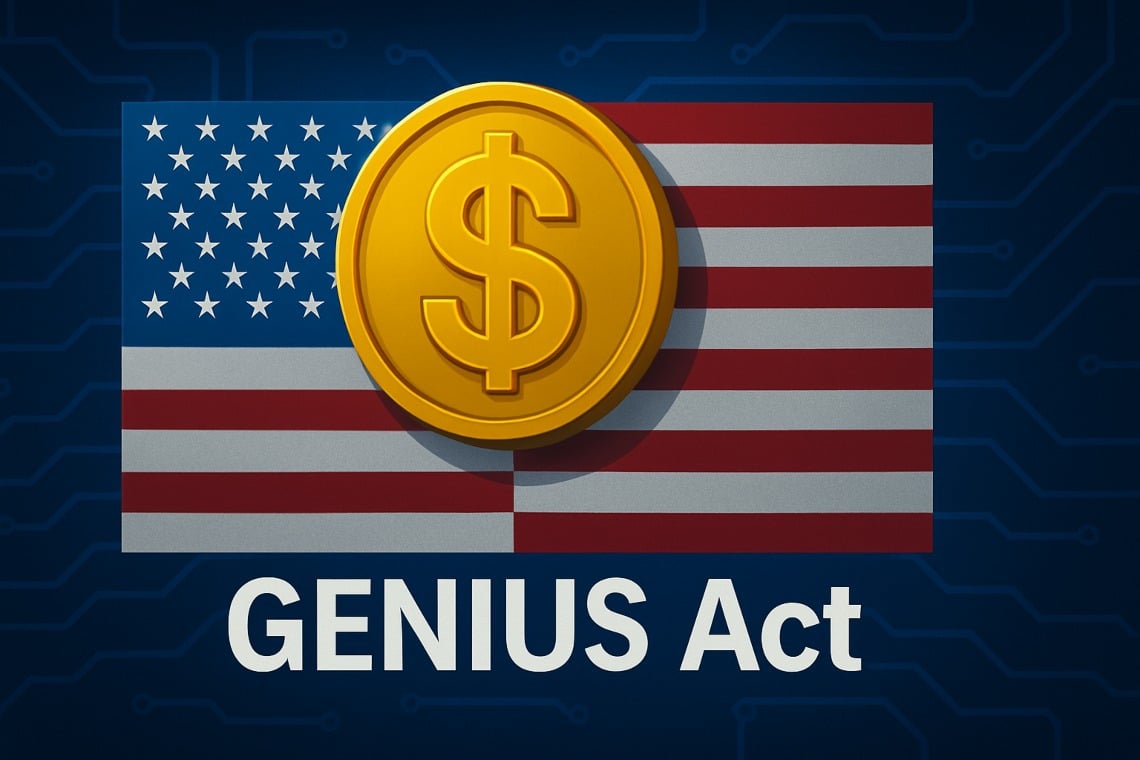What to Know About the Latest Crypto Stablecoin Legislation


KEY TAKEAWAYS
- The GENIUS Act (2025) is the first U.S. federal framework regulating payment stablecoins.
- It grants federal banking regulators oversight of permitted stablecoin issuers.
- Only federally licensed or qualified state issuers can legally issue payment stablecoins.
- Stablecoins issued under this Act are excluded from SEC and CFTC classifications as securities or commodities.
- Issuers must maintain 1:1 reserves, undergo regular audits, and follow AML/BSA compliance.
- The law viewks to enhance consumer protection, transparency, and market integrity.
In 2025, the landscape of cryptocurrency regulation reached a pivotal milestone with significant developments in the regulation of , digital assets designed to maintain stable value by being pegged to fiat currencies or other assets.
The most consequential legislative breakthrough in the United States is the enactment of the Guiding and Establishing National Innovation for U.S. Stablecoins Act (GENIUS Act), the first federal stablecoin regulatory framework. Other jurisdictions have also advanced stablecoin regulations, reflecting a global momentum to bring clarity, consumer protections, and financial stability to this emerging asset class.
This article dives deep into the latest crypto stablecoin legislation, highlighting the key provisions of the GENIUS Act, its implications on the U.S. market, global regulatory trends, and what market participants need to understand to navigate the evolving legal environment.
What Are Stablecoins and Why Do They Need Regulation?
Stablecoins are a special class of cryptocurrencies designed to minimize price volatility by pegging their value to fiat currencies such as the U.S. dollar or to baskets of assets like government bonds. They play a critical role in the broader crypto ecosystem by providing liquidity, serving as a medium of platform, and facilitating payments and settlements without the volatility typical in cryptocurrencies like or ETH.
Despite their promise, the rapid growth of stablecoins raised regulatory concerns over consumer protection, systemic financial risks, fraud, money laundering, and the potential for disruption to existing payment systems. High-profile stablecoin failures and a lack of transparent backing fueled calls for comprehensive regulation to ensure these digital assets are issued and managed responsibly.
The GENIUS Act: First Federal Stablecoin Legislation in the U.S.
On July 18, 2025, President Donald Trump signed into law the , representing a landmark federal law setting a regulatory regime for payment stablecoins in the U.S. This Act is the first comprehensive federal framework to govern digital asset issuance and oversight, overcoming the previously fragmented patchwork of state and federal controls.
Key Provisions of the GENIUS Act
The following points outline the main elements of the GENIUS Act,
- Regulatory Oversight: The law assigns regulatory authority over payment stablecoins issued by permitted entities to federal banking regulators. Issuers that are subsidiaries of insured depository institutions or federally licensed nonbank entities fall under the oversight of primary regulators such as the Office of the Comptroller of the Currency (OCC).
- Permitted Issuers: Only “permitted payment stablecoin issuers” authorized by federal regulators can issue payment stablecoins in the U.S. It prohibits issuance of such stablecoins by unauthorized entities, thus restricting the market to regulated participants with compliance obligations.
- Exclusion from Securities and Commodities Laws: The Act explicitly states that payment stablecoins issued by permitted entities are neither considered securities under federal securities laws nor commodities under the Commodity platform Act. This exclusion removes overlapping regulatory burdens from the and CFTC.
- Consumer Protections and Transparency: The legislation establishes standards to ensure stablecoin issuers maintain reserves backing the stablecoins 1:1 with high-quality assets, enforce transparency through audits, and comply with anti-money laundering (AML) and Bank Secrecy Act (BSA) requirements.
- State and Federal Balance: While establishing federal primacy over payment stablecoins, the Act allows certain state-level stablecoin issuers to be recognized if they meet qualifying state regulatory regimes, fostering cooperation between state and federal frameworks.
- Implementation Timeline: The GENIUS Act is effective 18 months later than enactment or 120 days later than federal regulators issue final implementing regulations, whichever comes first.
Implications of the GENIUS Act on the Market
The GENIUS Act ushers in a new era of regulatory certainty and legitimacy for U.S. stablecoins, with major impacts including:
- Institutional Adoption: By providing a clear compliance path and federal oversight, traditional banks and fintechs can confidently develop and issue stablecoins, enabling fintech innovation alongside legacy finance players.
- Payment System Integration: Regulatory clarity paves the way for stablecoins to be integrated into mainstream payment networks and cross-border remittances as trusted rails for value transfer.
- Consumer Confidence: Transparency and reserve requirements reduce risks of runs and failures, fostering consumer trust in stablecoins as reliable digital cash substitutes.
- Market Consolidation: Smaller noncompliant issuers face barriers or must transform business models, potentially consolidating the market around regulated entities.
Other Key Crypto Stablecoin Regulatory Developments Worldwide
The U.S. is not alone in regulating stablecoins. Globally, authorities have moved to frame crypto regulations aligned with emerging best practices:
- United Kingdom: The Financial Conduct Authority (FCA) proposed a regulatory framework for qualifying stablecoins, focusing on custody rules, operational resilience, and systemic risk management, set to complement Bank of England oversight for systemic stablecoins.
- Hong Kong: Enacted the in 2025, establishing licensing regimes to supervise fiat-backed stablecoin issuance and custodian activities on a mandatory basis.
- International Standards: Bodies like the Financial Stability Board (FSB) and the Bank for International Settlements (BIS) have published frameworks recommending stablecoin issuers uphold prudential standards akin to banks, emphasizing risk management and consumer protection globally.
Challenges and Considerations Moving Forward
While the GENIUS Act and international efforts represent progress, challenges remain for regulators and industry:
- Implementation Complexity: Specifying practical operational rules, reserve asset composition, transparency standards, and enforcement mechanisms requires ongoing regulatory guidance.
- Cross-Border Coordination: Stablecoins operate globally, necessitating international regulatory cooperation to avoid regulatory arbitrage and gaps.
- Innovation Balance: Regulators must allow room for innovation, DeFi integration, and new use cases without compromising securety.
- Consumer Education: Educating users on stablecoin risks, functionalities, and protections is critical for usability and trust.
What Stablecoin Market Participants Should Know
Below are essential insights and considerations for issuers, investors, and regulators navigating the evolving stablecoin ecosystem.
- Entities planning to issue stablecoins in the U.S. must begin preparing for compliance with the GENIUS Act, including obtaining federal licensing or partnering with insured banks.
- Market participants should align reserve practices to meet the Act’s requirements for asset quality and transparency, instituting robust audits and disclosures.
- Developers and platforms offering stablecoins need to verify issuance legitimacy and adjust listings to ensure only permitted payment stablecoins are marketed in the U.S.
- International stablecoin projects targeting the U.S. must evaluate the compliance of foreign-issued coins under exceptions within the GENIUS Act and engage with federal regulators.
The GENIUS Act and Beyond: Building Trust and Stability in the Global Stablecoin Era
The latest crypto stablecoin legislation, anchored by the GENIUS Act in the U.S., marks a watershed moment in the institutionalization and maturation of the stablecoin sector. By creating a defined regulatory framework with consumer protections, clear issuer eligibility, and federal oversight, the Act aims to establish stablecoins as trusted foundations of digital finance and payments innovation.
Globally, coordinated regulatory efforts are forging convergent standards to manage risks while supporting market development. Stablecoin issuers, users, and financial institutions must stay informed and proactive in adapting to these evolving legal landscapes to leverage stablecoins’ full promise securely and compliantly.
As 2025 unfolds, stablecoins are set to become a pillar of mainstream finance with enhanced security, transparency, and trust, ushered in by forward-looking legislation across key jurisdictions worldwide.
FAQ
What is the GENIUS Act, and why is it significant?
The GENIUS Act (Guiding and Establishing National Innovation for U.S. Stablecoins Act) is the first federal law providing a comprehensive regulatory framework for stablecoins in the U.S.
When does the GENIUS Act take effect?
The Act becomes effective 18 months later than enactment, or 120 days later than final federal regulations are issued, whichever comes first.
Who can issue stablecoins under the GENIUS Act?
Only “permitted payment stablecoin issuers” authorized by federal regulators, such as federally licensed banks or approved nonbank entities, are allowed to issue stablecoins in the U.S.
How does the GENIUS Act protect consumers?
It mandates full reserve backing, independent audits, operational transparency, and compliance with AML/BSA standards, reducing risks of fraud, insolvency, and instability.
Does the Act classify stablecoins as securities or commodities?
No. Stablecoins issued by permitted entities are explicitly excluded from the definitions of securities and commodities, removing overlapping oversight by the SEC and CFTC.
How will the Act affect smaller or unregulated issuers?
Noncompliant issuers may face market exclusion or forced restructuring, leading to industry consolidation around regulated participants.
What impact will this have on banks and fintech firms?
The Act provides a clear compliance path for traditional institutions to develop and issue stablecoins, encouraging mainstream financial integration and innovation.







